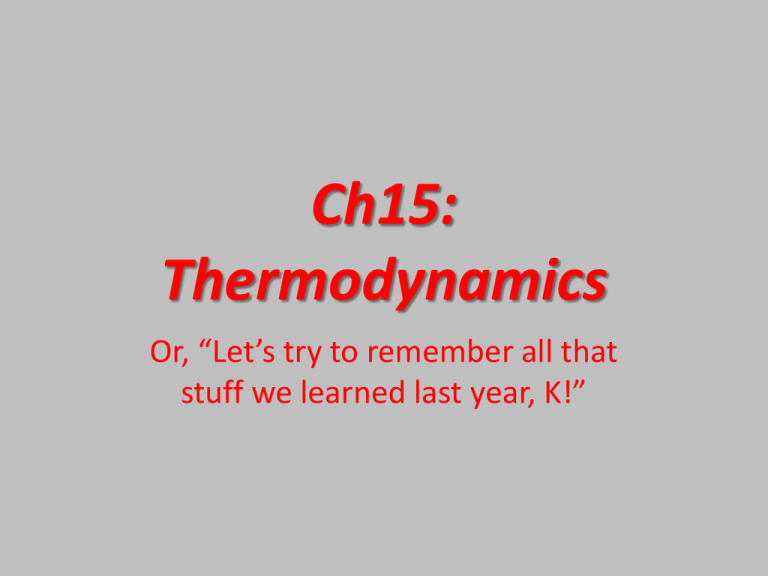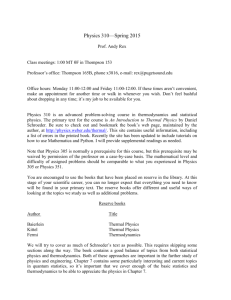Ch15: Thermodynamics Or, “Let’s try to remember all that
advertisement

Ch15: Thermodynamics Or, “Let’s try to remember all that stuff we learned last year, K!” Seriously… • Whatsup? –Ch 13, 14, & 15 simultaneously –Regular HW each chapter. • DUE DATES? Check CALENDAR! Heat & Thermodynamics Ch 15 – Thermodynamics Basic LAWS • 0th Law –Two systems individually in thermal equilibrium with a 3rd system are in equilibrium with each other. –Sorta like • If A=B & B=C, then A=C Online Thermal Thing Figure 15.3, 1st Law of T • The first law of thermodynamics is the conservation-of-energy principle stated for a system where heat and work are the methods of transferring energy for a system in thermal equilibrium. 𝑄 represents the net heat transfer—it is the sum of all heat transfers into and out of the system. 𝑄 is positive for net heat transfer into the system. 𝑊 is the total work done on and by the system. 𝑊 is positive when more work is done by the system than on it. The change in the internal energy of the system, Δ𝑈 , is related to heat and work by the first law of thermodynamics, Δ𝑈 = 𝑄 − 𝑊 . Figure 15.3 • The first law of thermodynamics is the conservation-of-energy principle stated for a system where heat and work are the methods of transferring energy for a system in thermal equilibrium. 𝑄 represents the net heat transfer—it is the sum of all heat transfers into and out of the system. 𝑄 is positive for net heat transfer into the system. 𝑊 is the total work done on and by the system. 𝑊 is positive when more work is done by the system than on it. The change in the internal energy of the system, Δ𝑈 , is related to heat and work by the first law of thermodynamics, Δ𝑈 = 𝑄 − 𝑊 . • 1st Law Basic LAWS –Internal energy of a system changes from an initial value Ui to a final value Uf due to heat Q and work W: • U = Uf – Ui = Q + W • Q>0 when system gains heat & <0 when it loses heat. • W>0 when work is done ON system & <0 when gas does work. • Basic LAWS st 1 Law –Internal energy of a system changes from an initial value Ui to a final value Uf due to heat Q and work W: • Q = Heat transferred to a system. • W = Work done ON a system QIN > 0 QOUT < 0 WON > 0 WBY < 0 QIN > 0 QOUT < 0 WON > 0 WBY < 0 Using the 1st LAW • 2500J of heat is added to a system, and 1800J of work is done on the system. Find change in internal energy of the system? U Q W U 2500 J 1800 U 4300 J Basic LAWS • 1st Law Example (p427) –T of 3 mol is reduced from 540K to 350K by adding 5500J of heat to it. • Find U & W done by or on gas. –T of 3 mol is reduced from 540K to 350K by adding 5500J of heat to it. • Find U & W done by or on gas. 3 U nRT 2 3 (3mol ) 8.31 J (350 540 K ) mol K 2 7100 J –T of 3 mol is reduced from 540K to 350K by adding 5500J of heat to it. • Find U & W done by or on gas. U W Q W U Q 7100 J 5500 J by or on gas? 12,600 J Using the 1st LAW • Work done on or by a gas? WBY Fd PAd WBY PV PV Diagrams 1st Law Thermal Processes • Isobaric – Constant P • W=PV • Isochoric (Isovolumetric) – Constant V • Isothermal – Constant T • Adiabatic – No transfer of heat Thermal Processes • Isobaric Copied from Emile Clapeyron’s Bio (1799 - 1864). Thermal Processes • Isochoric Copied from Emile Clapeyron’s Bio (1799 - 1864). Thermal Processes • Isothermal Copied from Emile Clapeyron’s Bio (1799 - 1864). Thermal Processes • Adiabatic Copied from Emile Clapeyron’s Bio (1799 - 1864). Thermal Processes • Since W=PV, Work is area under P/V graph. 1st Law Thermal Processes • Isobaric – Constant P • W=PV • Isochoric – Constant V • Isothermal – Constant T • Adiabatic – No transfer of heat Using the 1st LAW • Efficiency of a heat engine? W Q e 1 Q Q L H H Using the 1st LAW • Ideal efficiency (Carnot Engine)? T e 1 T L ideal H Carnot (IDEAL) Engine Carnot (IDEAL) Engine eCarnot TH TL TL 1 TH TH Basic LAWS • 2nd Law –Heat flows from a substance at higher temp to a substance at lower temp and does NOT flow in the reverse direction. Ever. Basic LAWS • 2nd Law & Entropy • Entropy, disorder or randomness, of the Universe increases Q S T S 0 Basic LAWS – 2nd • The total entropy of a system PLUS the environment increases as a result of heat flow. Q S T S 0 Basic LAWS • 3rd Law –Absolute Zero is impossible to reach in a finite number of steps. Ch 13-15 • HW Posted. • PSS next 1-2 classes





